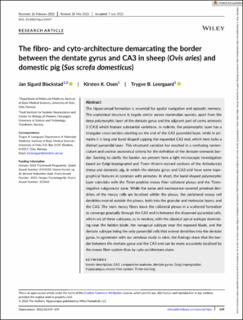| dc.contributor.author | Blackstad, Jan Sigurd Beddari | |
| dc.contributor.author | Osen, Kirsten Kjelsberg | |
| dc.contributor.author | Leergaard, Trygve Brauns | |
| dc.date.accessioned | 2023-02-07T08:50:48Z | |
| dc.date.available | 2023-02-07T08:50:48Z | |
| dc.date.created | 2022-08-02T09:11:29Z | |
| dc.date.issued | 2022 | |
| dc.identifier.citation | Hippocampus. 2022, 32 (9), 639-659. | en_US |
| dc.identifier.issn | 1050-9631 | |
| dc.identifier.uri | https://hdl.handle.net/11250/3048750 | |
| dc.description.abstract | The hippocampal formation is essential for spatial navigation and episodic memory. The anatomical structure is largely similar across mammalian species, apart from the deep polymorphic layer of the dentate gyrus and the adjacent part of cornu ammonis 3 (CA3) which feature substantial variations. In rodents, the polymorphic layer has a triangular cross-section abutting on the end of the CA3 pyramidal layer, while in primates it is long and band-shaped capping the expanded CA3 end, which here lacks a distinct pyramidal layer. This structural variation has resulted in a confusing nomenclature and unclear anatomical criteria for the definition of the dentate-ammonic border. Seeking to clarify the border, we present here a light microscopic investigation based on Golgi-impregnated and Timm–thionin-stained sections of the Artiodactyla sheep and domestic pig, in which the dentate gyrus and CA3 end have some topographical features in common with primates. In short, the band-shaped polymorphic layer coincides with the Timm-positive mossy fiber collateral plexus and the Timm-negative subgranular zone. While the soma and excrescence-covered proximal dendrites of the mossy cells are localized within the plexus, the peripheral mossy cell dendrites extend outside the plexus, both into the granular and molecular layers, and the CA3. The main mossy fibers leave the collateral plexus in a scattered formation to converge gradually through the CA3 end in between the dispersed pyramidal cells, which are of three subtypes, as in monkey, with the classical apical subtype dominating near the hidden blade, the nonapical subtype near the exposed blade, and the dentate subtype being the only pyramidal cells that extend dendrites into the dentate gyrus. In agreement with our previous study in mink, the findings show that the border between the dentate gyrus and the CA3 end can be more accurately localized by the mossy fiber system than by cyto-architecture alone. | en_US |
| dc.language.iso | eng | en_US |
| dc.publisher | Wiley Periodicals LLC. | en_US |
| dc.rights | Navngivelse 4.0 Internasjonal | * |
| dc.rights.uri | http://creativecommons.org/licenses/by/4.0/deed.no | * |
| dc.title | The fibro- and cyto-architecture demarcating the border between the dentate gyrus and CA3 in sheep (Ovis aries) and domestic pig (Sus scrofa domesticus) | en_US |
| dc.title.alternative | The fibro- and cyto-architecture demarcating the border between the dentate gyrus and CA3 in sheep (Ovis aries) and domestic pig (Sus scrofa domesticus) | en_US |
| dc.type | Peer reviewed | en_US |
| dc.type | Journal article | en_US |
| dc.description.version | publishedVersion | en_US |
| dc.source.pagenumber | 639-659 | en_US |
| dc.source.volume | 32 | en_US |
| dc.source.journal | Hippocampus | en_US |
| dc.source.issue | 9 | en_US |
| dc.identifier.doi | 10.1002/hipo.23457 | |
| dc.identifier.cristin | 2040538 | |
| dc.relation.project | Norges forskningsråd: 223262 | en_US |
| dc.relation.project | EU – Horisont Europa (EC/HEU): 945539 | en_US |
| dc.relation.project | Norges forskningsråd: 269774 | en_US |
| cristin.ispublished | true | |
| cristin.fulltext | original | |
| cristin.qualitycode | 1 | |

